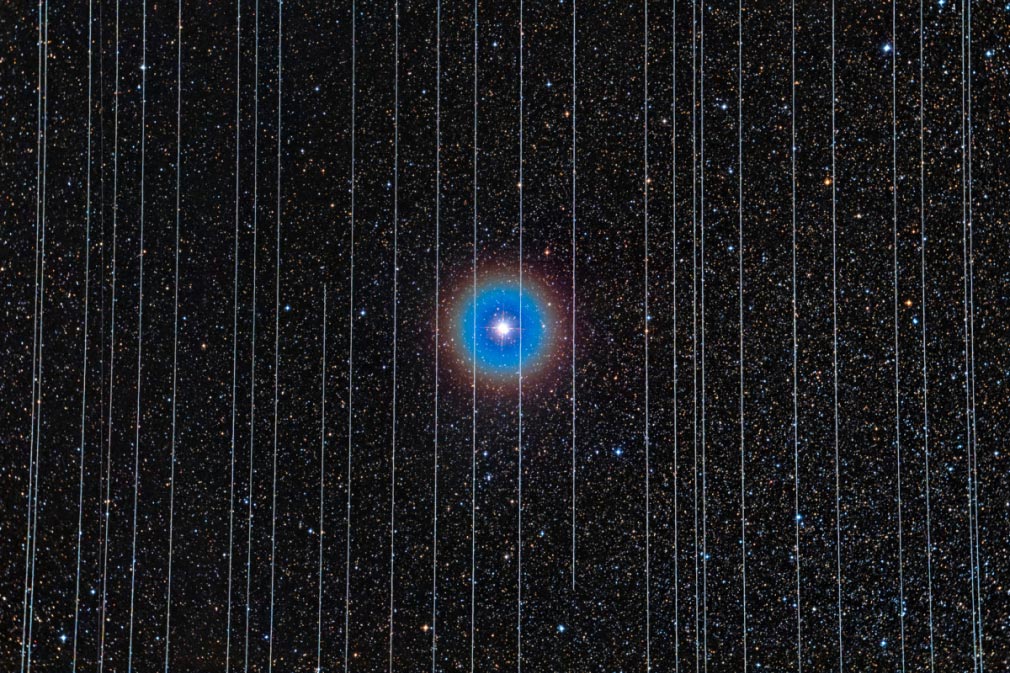
Our positions

DarkSky position statements address critical issues related to light pollution and dark skies. These position statements help inform all levels of our work, including our priorities, communications, advocacy, and policy agenda.
Our core principles are embodied in:
Here’s where we stand on:
- Satellite mega-constellations
- Outdoor sports and stadium lighting
- Correlated color temperature (CCT) and short-wavelength (blue) light
- High powered lights along the U.S.-Mexico border
- Light Justice
- Electronic Billboards, Electronic Message Centers
DARKSKY CORE PRINCIPLE
Five Principles for Responsible Outdoor Lighting
DarkSky and the Illuminating Engineering Society joined forces to prevent and reduce light pollution through the proper application of quality outdoor electric lighting.
DARKSKY POSITION STATEMENT
Satellite mega-constellations

Mega-constellations, also known as low earth-orbit (LEO) satellite constellations, are webs of networked satellites that orbit the Earth at altitudes of 2,000 km or less, providing global telecommunications services. The brightness and frequency of the objects have caused concern among the astronomy community and the general public.
The sheer number of satellites, combined with the brightness of the objects and the frequency of sightings, is a serious threat to the dark sky community. Astronomers, astrophotographers, and stargazers have all shared concerns about satellite mega-constellations polluting the night sky.
DarkSky is especially concerned about the threats that satellite mega-constellations pose to International Dark Sky Places. These places have taken measures to protect natural darkness, and offer millions of people around the globe the opportunity to observe the splendor of the night sky.
By the end of 2030, it’s projected that 50,000 satellites will be in low Earth orbit — a 2,400% increase in a single decade. The reflected light from these satellite swarms may increase the night sky’s brightness by 250% — erasing 50% of all stars from view.
Simulations also show that without mitigation, approximately one out of every fifteen points of light in the night sky will be a satellite. This would fundamentally alter the night sky so that for the first time in history, we would see more human-made patterns in the sky than we would see the stars.
DarkSky’s five principles to preserve the quiet enjoyment of the night sky and protect the general public from the impacts of satellite mega-constellations are:
- Stewardship of the night sky is a shared responsibility that requires participation and consultation with all stakeholders.
- The cumulative impact on night sky brightness attributed to satellites does not exceed 10 percent above natural background levels.
- Maintained satellite brightness is below the threshold for detection by the unaided eye.
- Satellite visibility is an unusual occurrence.
- Launch schedules and orbital parameters are publicly available in advance.
Adopted January 2020; amended September 2021.
DARKSKY POSITION STATEMENT
Outdoor sports and stadium lighting

In recent years, we’ve witnessed a marked increase in the number of outdoor sports lighting complexes built in urban and suburban neighborhoods. These facilities are constructed at schools, parks, and neighborhood complexes. The excessive amount of light associated with these complexes can be a nuisance for neighborhoods and create significant environmental impacts.
Recognizing the urgent need for leadership to encourage and promote community-friendly sports lighting designs, the DarkSky Technical Committee released the following criteria:
By adopting DarkSky’s Community-Friendly Outdoor Sports Lighting (OSL) program guidelines, your community will:
- Minimize neighborhood lighting nuisance by greatly reducing local spill and glare.
- Manage high angle light pollution, thus dramatically decreasing off-site light trespass and sky glow.
- Mitigate neighborhood light pollution and sky glow, which will benefit the environment, the astronomy community, and others impacted by poorly designed outdoor sports facilities.
- Minimize lumen densities, thereby reducing energy consumption.
Adopted March 2018.
DARKSKY POSITION STATEMENT
High-powered lights along the U.S.-Mexico border

In the United States, few locations remain where the night is naturally dark. One of these is stretches forms part of the border between the United States and Mexico. In April 2022, the Greater Big Bend International Dark Sky Reserve, which straddles the U.S.-Mexico border, was certified in recognition of decades of work to protect its dark skies.
Today, high-power stadium lights threaten some of these last dark places. Recognizing this, DarkSky’s Board of Directors recently reviewed the situation and adopted the following position:
- To oppose the installation of any future permanent lighting systems in stretches of the borderlands that would qualify for protection under the International Dark Sky Places program by way of their sky quality.
- To urge the Federal Government to decommission, disable, or otherwise ensure that the installed lights are not turned on.
This decision relates solely to the installation and use of light, not the overall border wall project.
Adopted July 2022 (read more in the blog post).
DARKSKY POSITION STATEMENT
Light justice
Access to a naturally dark sky and quality lighting are not a privilege but a right of all people. Light pollution impacts low-income communities disproportionately — and has only recently been recognized as an environmental justice issue, despite a troubling history. Harsh, inappropriate lighting affects quality of life and robs communities of their connection to the cosmos. Unfortunately, inappropriate lighting is widely used by municipalities and housing developments under the guise of safety. Light justice is as much about access to responsible, community-friendly lighting as it is about access to the pure night sky.
Our work to promote light justice starts from within. Recognizing that this effort is a marathon and not a sprint, our team has worked over the last year to look inward through the lens of inclusion, diversity, equity, and access (IDEA). With expert guidance, DarkSky’s team collectively revisited its purpose, vision, and core values to include robust and direct language addressing IDEA principles.
Adopted July 2021.
DARKSKY POSITION STATEMENT
Electronic billboards

Electronic billboards (a.k.a. electronic message centers, or EMCs) can be up to ten times brighter at night than traditionally lit billboards and can be harmful to the nighttime environment. LED light emitted from EMCs cannot be shielded, so the light floods into the night sky, which wastes energy and contributes to light pollution. Light from EMCs can cause glare and be a dangerous distraction to drivers. In some cases, EMC light can be visible from long distances and may affect the breeding, foraging, and orientation behaviors of nocturnal wildlife.
However, when installed and operated in accordance with DarkSky’s guidance for electronic message centers, EMCs replacing traditionally floodlight-illuminated billboards can actually create a net reduction in sky brightness.
The DarkSky Technical Committee developed EMC Guidelines (PDF) to provide planners, lighting designers, architects, biologists, government officials, and the general public with solutions for EMCs, both on and off premises, that minimize harm to the natural night and even reduce sky brightness when replacing inappropriately lit signs and billboards.
The guidelines …
- Recommend best practices for the amount of light emitted by electronic billboards and signs for urban, suburban, and rural areas
- Recommend curfews for when signs and billboards should be turned off
- Identify best management practices to decrease or eliminate negative impacts on the environment, reduce visual clutter, and improve safety for drivers and pedestrians
Adopted January 2019.



















